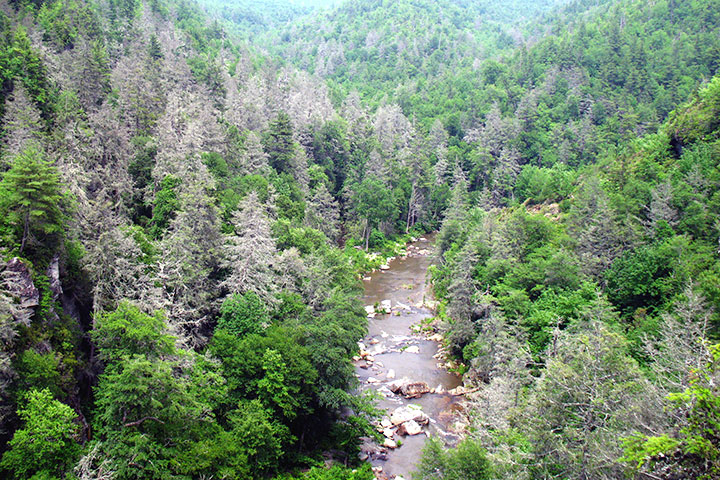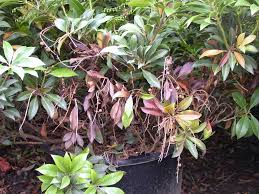
I have blogged many times about the risk of pest introductions on imports of live plants [= “plants for planting” in USDA’s terms]. Last October I reviewed 14-year old data indicating that nearly 70% of 455 damaging tree pests introduced to the continental U.S. had probably been introduced via plant imports. These included 95% of sap feeding and 89% of foliage feeding insects and about half of the pathogens. The approach rate of pests on imported plants was apparently 12% (Liebhold et al. 2012) — more than 100 times higher than the 0.1% approach rate found by Haack et al. (2014) for wood packaging.
First, those analyses focus almost exclusively on insects (MacLachlan et al. 2022 focused on a single insect order, the Hemiptera!), despite the many pathogens probably introduced by the plant trade in recent decades. Examples I cited included several Phytophthoras, rapid ohia death, beech leaf disease, and boxwood blight. There have been repeated detections of the Ralstonia solanacearum Race 3 biovar 2.
Second, most studies analyzing the pest risk associated with plant imports use port inspection data – which are not reliable indicators of the pest approach rate – as explained by Liebhold et al. 2012 and Haack et al. 2014 (as it pertains to wood packaging).
Third, many of the studies are based on data from a decade or longer in the past. This means the studies do not address whether APHIS’ recent changes in its approach – including adoption of NAPPRA – have resulted in reduced introductions.
A complication is that, since insects are difficult to detect, those associated with the high volumes of plants imported in recent years might not be detected for years or decades after their introduction.
I have called for APHIS to update the Liebhold et al. 2012 study to determine the approach rate for all types of organisms that threaten North American tree species. Any such study should include trees on Hawai`i, Guam, Puerto Rico, and other U.S possessions and territories. These islands are nearly always excluded from analyses of imported pests. I concede that there are probably scientific and data-management challenges but these islands are immensely important from a biodiversity point of view, and they are parts of the United States!

MacLachlan et al. (2022) estimated that new establishments – of insects in the order Hemiptera – per unit of additional plant imports have shrunk substantially. They attribute this decline to a combination of increased imports and the presence of a growing number of insect species introduced in the past. They found that introductions to the Asian Palearctic and Neotropic regions have been reduced by depletion of species pools. Other factors are thought to explain the substantial decline in establishment likelihood for the other regions. However, lag times in detecting insect introductions complicate this assessment.
However, despite that significant decrease in risk per unit of imports, MacLachlan et al. (2022) found that the number of establishments has remained relatively constant over the past century because of substantial increases in overall import levels and diversification of the origins of imports across regions, which exposed the U.S. to new source species pools.
MacLachlan et al. (2022) suggested that APHIS should target biosecurity resources to the specific commodity-country pairs associated with a higher relative risk of introducing additional insect species.
Recent studies are taking a welcome new stance: looking at links between introductions of non-native plant and insect species. I first raised this approach a year ago. Studies by teams led by Doug Tallany and Sara Lalk [Lalk et al.; articles by Tallamy] agree that:
- Non-native plants – some of which are invasive – are altering ecosystems across broad swaths of North America and the impacts are insufficiently understood.
- The invasive plant problem will get worse because non-native species continue to be imported, planted … and to invade.
- Plant-insect interactions are the foundation of food webs – they transfer energy captured by plants through photosynthesis to other trophic levels, plus play a major role as pollinators. Consequently, changes to a region’s flora will have repercussions throughout ecosystems.
Dr. Tallamy studies the response of herbivorous insects to non-native woody plants – not just invasive plants, but also non-native plants deliberately planted as crops or ornamentals, or in forestry. Introduced plants have completely transformed the composition of plant communities in both natural and human-dominated ecosystems world-wide. The impacts can be significant: Burghardt et al. found that 75% of North American lepidopteran species and 93% of specialist species were found exclusively on native plant species.

Lalk and colleagues studied the relationships between individual species of invasive woody plants and the full range of arthropod feeding guilds – pollinators, herbivores, twig and stem borers, leaf litter and soil organisms. They decry the absence of data on the complex interactions between invasive woody plants and arthropod communities at a time when invasive shrubs and trees are so widespread and causing considerable ecological damage. (See the blog for their specific research recommendations.)
Nor is the impact of non-native plants on insect fauna limited to North America. Outhwaite et al. found that the combination of climate warming and intensive agriculture is associated with reductions of almost 50% in the abundance and 27% in the number of species within insect assemblages relative to levels in less-disturbed habitats with lower rates of historical climate warming. These patterns were particularly clear in the tropics (perhaps partially because of the longer history of intensive agriculture in temperate zones). They found that high availability of nearby natural habitat (that is, native plants) can mitigate these reductions — but only in low-intensity agricultural systems.
Recognizing that plant diversity drives global patterns of insect invasion, Liebhold et al. (2023) compared various factors associated with numbers of invasive insect species in 44 land areas.They determined that the numbers of established non-native insect species are primarily driven by diversity of plants – both native and non-indigenous. Other factors, e.g., land area, latitude, climate, and insularity, strongly affect plant diversity; thus they influence insect diversity as a secondary impact. When I blogged about this study, I noted that the article appeared more than four years earlier, but has apparently had little influence on either policy formulation governing plant introductions or pest risk analysis applied to insects or pathogens that might be introduced. I suggested that we need a separate analysis of whether fungi, oomycetes, nematodes, and other pathogens show the same association with plant diversity in the receiving environment.
Studies of plant-insect relationships continue to be published. I welcome this!
Bonnamour et al. (2023) builds on the earlier studies. They also found that the presence of non-native plant species was a better predictor of insect invasions than such more widely discussed socioeconomic variables as trade volumes generally or even trade in plant products. However, detection of the associated insect invasions occurs years after detection of the plant invasions. Indeed, numbers of established non-native insect species corresponded more closely to plant introduction volumes in 1900 than current or recent import volumes.
Bonnamour et al. note that while the insect taxa that respond most directly to the non-native plant diversity are those that rely on those plants as hosts, pollinators, and plant visitors, over time those non-native herbaceous insects support introduced predators and parasites also.
Because of the “invasion debt” associated with that lag, Bonnamour et al. estimate that newly detected insect invasions will increase by 35% worldwide as a result of only recent plant introductions. They differentiate this “invasion debt” from “future invasions”, meaning the actual introduction of additional species resulting from future trade activities.
The model developed by Bonnamour et al. points to the highest numbers of newly introduced insect species occurring in areas with less capacity to deal with bioinvasions. Thus, the Afrotropics are anticipated to receive 869 new insect species, or a 10-fold increase over the number currently known to be established in the region. The Neotropics are projected to be invaded by 809 insect species, also a 10-fold increase. The Indomalayan region will probably detect 776 new insect species, a startling 20-fold increase. In reality, the “invasion debt” might not be quite this severe, since – as Bonnamour et al. note several times – the low numbers of introduced insects currently reported for these tropical regions probably partially reflect limited sampling. They note that already a high proportion of insect species intercepted by biosecurity services on imports arriving from Africa and South America are not yet recorded as established in the exporting regions.
Although both the European Palearctic and Australasia have already received many non-native insect species, their “invasion debt” is relatively high: 417 species for Europe, 317 species for Australasia.
The Neotropics are expected to be the greatest source of insect invasions in the future (904 exported species), followed by the European Palearctic (732 species).
Bonnamour et al. did not include non-native plant species used in agriculture, forestry, or ornamental horticulture. As noted above, these widespread deliberate plantings also affect insect fauna and higher trophic layers.
The greatest number of recorded insect introductions so far are in the Nearctic, Oceania (primarily Hawaii), Europe, and Australasia. While this imbalance is probably caused in part by the significantly limited sampling of non-native insect species in the Asian Palearctic and tropics, it is also true that these regions have received the majority of plant introductions through 1900. This factor has changed in the century since then; many non-native plant species have been recorded in the Afrotropics, Oceania, and Asia.
Bonnamour et al. offer several potential explanations for the lag in detecting introduced insects compared to detecting introduced plants. First, it might be necessary for non-native host plants to reach a threshold of abundance before the associated insects are able to establish and spread. Second, reaching that threshold might require repeated introductions of the insect’s host plant species. Third, since only some of the imported plants are transporting insects, repeated imports of host plants might be necessary for the insect to achieve sufficient numbers to establish. Fourth, while their analysis included all non-native insect species, only some insect feeding guilds – herbivores and pollinators – are probably directly facilitated by introduced host plants. Fifth, plant species’ presence tends to be more quickly recorded than insects’ presence. Indeed, MacLaughlin et al. reported a median delay of 80 years between establishment and discovery of plant-feeding Hemiptera. This suggests that the actual time lag between plant and insect establishments might be shorter than the period discussed in Bonnamour et al.
Many insects from the European Palearctic have been introduced to the Nearctic; fewer insects have been introduced in the opposite direction. There is no consensus on the explanation. Thirty years ago Mattson et al. argued that there might be fewer niches for non-native insects in Europe due to the lower host plant diversity in this region caused by the Pleistocene/Holocene glaciations. On the other hand, more plant species from the European Palearctic to the Nearctic than the opposite.
Bonnamour et al. call for further research on:
1) time lags at the scale of individual insect species with their host plants.
2) effects of non-native plants used in agriculture, forestry, or ornamental horticulture.
3) whether time lags between plant and insect invasions vary among taxonomic groups, feeding guilds, or among regions.
4) effect of non-native plant abundance, rather than just species richness, on non-native insect establishment.
Recommendations
Writers about interactions of non-native plant species and insect introductions make a common plea: limit the introduction and spread of non-native plants in order to prevent future invasions of both plants and insects. Bonnamour et al. suggest including the risk of insect introductions in plant invasion risk screening tools. Earlier, the Tallamy and Lalk teams called for ending widespread planting of non-native plants.

Will policy-makers accept this advice?
I believe that these same interaction of plant host and “pest” introductions presumably applies to pathogens, too. I reiterate my frequent complaint that regulators have not responded to two or more decades of criticism of the failures of the international phytosanitary system re: insect and pathogen introductions via the international nursery trade. Examples include Brasier 2008; Liebhold el. al. 2012; Santini et al. 2013; Roy et al. 2014; Eschen et al. 2015; Jung et al. 2015; Meurisse et al. 2019; O’Hanlon et al. 2021.
As I have said earlier, I appreciate that some scientists are trying to reduce scientific uncertainty about the invasive potential of pathogens native to regions other than North America; I refer here to Jiri Hulcr (see Li et al.), Mech, and Schultz. Many more such studies are needed, addressing potential impacts on a wider variety of North American host trees and shrubs.
The late (& very much lamented!) Gary Lovett of the Cary Institute had advocated halting imports of plants that are congenerics of important North American tree species, in order to minimize the risk that pests that damage those genera will be introduced.
In January I suggested that at the global level we need:
- National agricultural agencies, stakeholders, FAO & International Plant Protection Convention (IPPC) should consider amending the IPPC requirement that scientists identify a disease’s causal agents before regulating it. Experience shows that this policy virtually guarantees that pathogens will continue to enter, establish, & damage natural and agricultural environments.
- National governments & FAO / IPPC should fund greatly expanded research to identify microbes resident in regions that are important sources of origin for traded plants, vulnerability of hosts in importing countries, and new technologies for detecting pathogens (e.g., molecular tools, volatile organic compounds [VOCs]).
- Researchers & agencies should expand international “sentinel plants” networks; incorporate data from forestry plantations, urban plantings, etc. of non-native trees.
- NPPOs should adopt regulations that apply the “systems approach” or HACCP programs outlined in ISPM#36. I had discussed these approaches in my Fading Forests III report – link at end of this blog.)
I suggested further that Americans need to
- Evaluate the efficacy of current regulations – that is, implementing NAPPRA & Q-37 revision. This evaluation should be based on AQIM data, not port interception data. It should include arthropods, fungal pathogens, oomycetes, bacteria, viruses, nematodes. It should include threats to U.S. tropical islands (Hawai`i, Puerto Rico, Guam, etc.) which are centers of plant endemism.
- Apply existing programs (e.g., NAPPRA, Clean Stock Network, post-entry quarantine) to strictly regulate trade in plant taxa most likely to transport pests that threaten our native plants; e.g., plants belonging to genera shared between North American trees & plants on other continents.
- Recognize that plant nurseries are incubators for microbial growth, hybridization, and evolution; require nurseries to adopt sanitary operation procedures regardless of whether they sell in inter-state or intra-state commerce
SOURCES
Bonnamour, A., R.E. Blake, A.M. Liebhold, H.F. Nahrung, A. Roques, R.M. Turner, T. Yamanaka, and C. Bertelsmeier. 2023. Historical plant intros predict current insect invasions. PNAS 2023 Vol. 120 No. 24 e2221826120 https://doi.org/10.1073/pnas.2221826120
Burghardt, K. T., D. W. Tallamy, C. Philips, and K. J. Shropshire. 2010. Non-native plants reduce abundance, richness, and host specialization in lepidopteran communities. Ecosphere 1(5):art11. doi:10.1890/ES10-00032.
Lalk, S. J. Hartshorn, and D.R. Coyle. 2021. IAS Woody Plants and Their Effects on Arthropods in the US: Challenges and Opportunities. Annals of the Entomological Society of America, 114(2), 2021, 192–205 doi: 10.1093/aesa/saaa054
Li, Y., C. Bateman, J. Skelton, B. Wang, A. Black, Y-T. Huang, A. Gonzalez, M.A. Jusino, Z.J. Nolen, S. Freeman, Z. Mendel, C-Y. Chen, H-F. Li, M. Kolařík, M. Knížek, J-H. Park, W. Sittichaya, T-H.
Pham, S. Itoo, M. Torii, L. Gao, A.J. Johnson, M. Lur, J. Sun, Z. Zhang, D.C. Adams, J. Hulcr. 2022. Pre-invasion assessment of exotic bark beetle-vectored fungi to detect tree-killing pathogens. https://apsjournals.apsnet.org/doi/full/10.1094/PHYTO-01-21-0041-R
Liebhold, A.M., E.G. Brockerhoff, L.J. Garrett, J.L. Parke, and K.O. Britton. 2012. Live Plant Imports: the Major Pathway for Forest Insect and Pathogen Invasions of the US. www.frontiersinecology.org
Liebhold, A.M., T. Yamanaka, A. Roques, S. August, S.L. Chown, E.G. Brockerhoff & P. Pyšek. 2018. Plant diversity drives global patterns of insect invasions. Sci Rep 8, 12095 (2018). https://doi.org/10.1038/s41598-018-30605-4
MacLachlan, M.J., A. M. Liebhold, T. Yamanaka, M. R. Springborn. 2022. Hidden patterns of insect establishment risk revealed from two centuries of alien species discoveries. Sci. Adv. 7, eabj1012 (2021).
Mattson, W. J., P. Niemela, I. Millers, and Y. Ingauazo. 1994. Immigrant phytophagous insects on woody plants in the United States and Canada: an annotated list. USDA For. Ser. Gen. Tech. Rep. NC-169, 27 pp.
Mech, A.M., K.A. Thomas, T.D. Marisco, D.A. Herms, C.R. Allen, M.P. Ayres, K.J.K. Gandhi, J. Gurevitch, N.P. Havill, R.A. Hufbauer, A.M. Liebhold, K.F. Raffa, A.N. Schulz, D.R. Uden, and P.C. Tobin. 2019. Evolutionary history predicts high-impact invasions by herbivorous insects. Ecol Evol. 2019 Nov; 9(21): 12216-12230.,
Outhwaite, C.L., P. McCann, and T. Newbold. 2022. Agriculture and climate change are shaping insect biodiversity worldwide. Nature 605 97-192 (2022) https://www.nature.com/articles/s41586-022-04644-x
Richard, M., D.W. Tallamy and A.B. Mitchell. 2019. Intro plants reduce species interactions. Biol Invasions https://doi.org/10.1007/s10530-018-1876-z
Schulz, A.N., A.M. Mech, M.P. Ayres, K. J. K. Gandhi, N.P. Havill, D.A. Herms, A.M. Hoover, R.A. Hufbauer, A.M. Liebhold, T.D. Marsico, K.F. Raffa, P.C. Tobin, D.R. Uden, K.A. Thomas. 2021. Predicting non-native insect impact: focusing on the trees to see the forest. Biological Invasions.
Tallamy, D.W., D.L. Narango and A.B. Mitchell. 2020. Ecological Entomology (2020), DOI: 10.1111/een.12973 Do NIS plants contribute to insect declines? Conservation Biology DOI: 10.1111/j.1523-1739.2009.01202.x
Uden, D.R, A.M. Mech, N.P. Havill, A.N. Schulz, M.P. Ayres, D.A. Herms, A.M. Hoover, K.J. K. Gandhi, R.A. Hufbauer, A.M. Liebhold, T.D. M., K.F. Raffa, K.A. Thomas, P.C. Tobin, C.R. Allen. 2023. Phylogenetic risk assessment is robust for forecasting the impact of European insects on North American conifers. Ecological Applications. 2023; 33:e2761.
Posted by Faith Campbell
We welcome comments that supplement or correct factual information, suggest new approaches, or promote thoughtful consideration. We post comments that disagree with us — but not those we judge to be not civil or inflammatory.
For a detailed discussion of the policies and practices that have allowed these pests to enter and spread – and that do not promote effective restoration strategies – review the Fading Forests report at http://treeimprovement.utk.edu/FadingForests.htm
or


